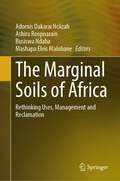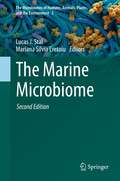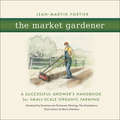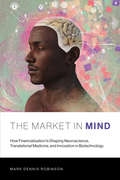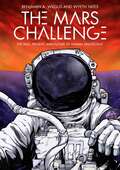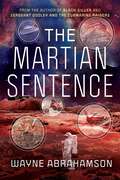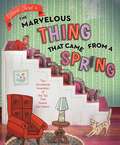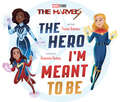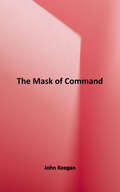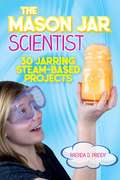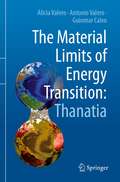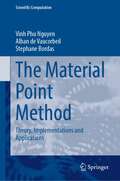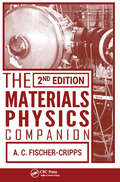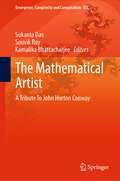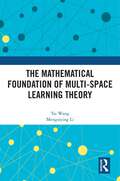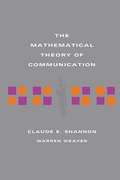- Table View
- List View
The Mapping of Power in Renaissance Italy
by Mark RosenHow did maps of the distant reaches of the world communicate to the public in an era when exploration of those territories was still ongoing and knowledge about them remained incomplete? And why did Renaissance rulers frequently commission large-scale painted maps of those territories when they knew that they would soon be proven obsolete by newer, more accurate information? The Mapping of Power in Renaissance Italy addresses these questions by bridging the disciplines of art history and the histories of science, cartography, and geography to closely examine surviving Italian painted maps that were commissioned during a period better known for its printed maps and atlases. Challenging the belief that maps are strictly neutral or technical markers of geographic progress, this well-illustrated study investigates the symbolic and propagandistic dimensions of these painted maps as products of the competitive and ambitious European court culture that produced them.
The Marathon of the Messenger: A History of Messenger RNA Vaccines
by Jérôme Lemonnier Nicolas LemonnierThe Covid-19 pandemic changed the world. Indeed a real race took place worldwide between SARS-CoV-2 on the one hand and researchers on the other – especially those specializing in messenger RNA vaccines. Four years after its emergence, the pandemic is not over, but some decisive battles have been won, thanks to the great success of mRNA vaccines. The Marathon of The Messenger presents the history of these mRNA vaccines, combining a scientific background with historical and economic perspectives. It appears that an important page in the history of these new vaccines was written in Europe, thanks to the crucial work of German and French scientists; this effort began in 1993 and continues to this day. In the face of a prevailing single-mindedness, these researchers pushed through a new therapeutic concept and defined the biotechnological keys that would open the way to the production of therapeutic messenger RNA in the fight against cancer and viral infections. Written for a broad audience and accompanied by humorous cartoons, this book will appeal to anyone looking for scientific and historical answers about mRNA vaccines. Readers will discover not only the technical and scientific knowledge of how these vaccines work, but also the economic levers that were necessary to create this technology. This book has been written in collaboration with Dr. Steve Pascolo, former director of CureVac, and the RNA messenger expert Professor Chantal Pichon. It also features a preface by Dr. Pierre Meulien, former director of the European Union public-private partnership Innovative Medicines Initiative (IMI).
The Marginal Soils of Africa: Rethinking Uses, Management and Reclamation
by Adornis Dakarai Nciizah Ashira Roopnarain Busiswa Ndaba Mashapa Elvis MalobaneThis book addressed the pressing challenges of climate change, land scarcity, and food security, offering a comprehensive synthesis of research on using, managing, and reclaiming marginal lands in Africa. Unfavourable climatic conditions and rapid population growth intensify competition for land, putting pressure on traditional agricultural soils thus necessitating a transition towards underutilized marginal lands. Reclaiming these damaged and undervalued areas through various technologies presents a promising path not only to food independence but also to second-generation biofuel feedstock production, utilizing excess biomass from these revived lands. While recent years have seen increased focus on restoring degraded lands, a crucial gap remains i.e. a unified knowledge base detailing the efficacy of various reclamation technologies. This book fills that void, empowering farmers and policymakers with the insights they need to make informed decisions, mobilize resources effectively, and ultimately help Africa meet its projected 60% food demand increase.
The Marine Microbiome (The Microbiomes of Humans, Animals, Plants, and the Environment #3)
by Lucas J. Stal Mariana Silvia CretoiuThis updated and expanded second edition reviews numerous aspects of the marine microbiome and its possible industrial applications. The marine microbiome is the total of microorganisms and viruses in the ocean and seas and in any connected environment, including the seafloor and marine animals and plants. In the first part of the book, diversity, origin and evolution of the marine microorganisms and viruses are discussed. The microbes presented originate from all three domains of life: Bacteria, Archaea, and Eukarya. The second part sheds some light on the different communities: it describes marine habitats and how their inhabitants control biogeochemical cycles. The third part finally examines the microbial ocean as a global system and evaluates methods of utilizing marine microbial resources. Adopting a translational approach, the book connects academic research with industrial applications, making it a fascinating read and valuable resource for microbiologists from both domains.
The Maritime Dimension of Sustainable Energy Security (Lecture Notes in Energy #68)
by Kapil NarulaThe maritime domain and sustainable energy are two critical aspects of the twenty first century which will shape the future of humanity. Although the maritime domain is inextricably interlinked with Sustainable Energy Security (SES), many aspects are discussed in isolated silos. This book aims to fill in this gap by presenting a holistic view of the maritime dimension of SES. It includes various topics such as the global energy system, energy supply chains, energy trade, shipping of energy commodities, energy markets, protection of maritime energy supply lines and the role of military in providing maritime security. It also focuses on harnessing offshore energy resources, both hydrocarbons and marine renewable energy and discusses the developments in lowering emissions from the shipping sector. The book is written for the general reader as well as students who are undergoing a course in energy systems, maritime management, naval studies and energy sustainability. The content is tailored to meet the intellectual curiosity of the inquisitive reader and introduces various specialized topics which are dealt in a simple and concise manner. It is hoped that this book would bridge the gap in the understanding of the maritime dimension of SES.
The Market Gardener: A Successful Grower's Handbook for Small-Scale Organic Farming
by Jean-Martin Fortier&“Few books have grabbed my attention as dramatically as this one—because it&’s ultimately do-able for thousands of would-be food and farm healers.&” —Joel Salatin, Polyface Farm Grow better not bigger with proven low-tech, human-scale, biointensive farming methods Making a living wage farming without big capital outlay or acreages may be closer than you think. Growing on just 1.5 acres, Jean-Martin and Maude-Helene feed more than 200 families through their thriving CSA and seasonal market stands. The secret of their success is the low-tech, high-yield production methods they&’ve developed by focusing on growing better rather than growing bigger, making their operation more lucrative and viable in the process. The Market Gardener is a compendium of proven horticultural techniques and innovative growing methods. This complete guide is packed with practical information on: · Setting-up a micro-farm by designing biologically intensive cropping systems, all with negligible capital outlay · Farming without a tractor and minimizing fossil fuel inputs through the use of the best hand tools, appropriate machinery and minimum tillage practices · Growing mixed vegetables systematically with attention to weed and pest management, crop yields, harvest periods and pricing approaches. Inspired by the French intensive tradition of maraichage and by iconic American vegetable grower Eliot Coleman, author and farmer Jean-Martin shows by example how to start a market garden and make it both very productive and profitable. &“Very well done and should be of great use to market growers everywhere.&” —Eliot Coleman, organic farming pioneer and author of The New Organic Grower &“Both visionary and practical, it is a work of rare intelligence.&” —Charles Herve-Gruyer, permaculture teacher and grower at la Fermedu BecHellouin, France
The Market in Mind: How Financialization Is Shaping Neuroscience, Translational Medicine, and Innovation in Biotechnology (The\mit Press Ser.)
by Mark Dennis RobinsonA critical examination of translational medicine, when private risk is transferred to the public sector and university research teams become tech startups for global investors.A global shift has secretly transformed science and medicine. Starting in 2003, biomedical research in the West has been reshaped by the emergence of translational science and medicine—the idea that the aim of research is to translate findings as quickly as possible into medical products. In The Market in Mind, Mark Dennis Robinson charts this shift, arguing that the new research paradigm has turned university research teams into small biotechnology startups and their industry partners into early-stage investment firms. There is also a larger, surprising consequence from this shift: according to Robinson, translational science and medicine enable biopharmaceutical firms, as part of a broader financial strategy, to outsource the riskiest parts of research to nonprofit universities. Robinson examines the implications of this new configuration. What happens, for example, when universities absorb unknown levels of risk? Robinson argues that in the years since the global financial crisis translational science and medicine has brought about “the financialization of health.”Robinson explores such topics as shareholder anxiety and industry retreat from Alzheimer's and depression research; how laboratory research is understood as health innovation even when there is no product; the emergence of investor networking events as crucial for viewing science in a market context; and the place of patients in research decisions. Although translational medicine justifies itself by the goal of relieving patients' suffering, Robinson finds patients' voices largely marginalized in translational neuroscience.
The Mars Challenge: The Past, Present, and Future of Human Spaceflight
by Benjamin A. WilgusTravel to deep space and back again with The Mars Challenge, a nonfiction graphic novel for teens about the science and logistics of a manned mission to Mars.Nadia is a teen with a dream: to be the first woman on Mars. But to get there, she's got to learn all she can about the science of spaceflight. It's a good thing her friend Eleanor is an Attitude Determination and Control Officer—basically, she pilots the International Space Station!Eleanor takes Nadia on a conceptual journey through an entire crewed mission to Mars, and explains every challenge that must be overcome along the way; from escaping Earth's gravity well, to keeping the crew healthy as they travel through deep space, to setting up a Mars base, to having enough fuel for the trip home! In The Mars Challenge, writer Benjamin A. Wilgus and artist Wyeth Yates bring the reader on a thrilling interplanetary voyage and clearly illustrate the scientific concepts and complex machinery involved. Humans can reach Mars in our lifetime—this book explains how it can be done.
The Martian Sentence
by Wayne AbrahamsonIn The Martian Sentence, an ancient artifact sparks a race across time and space. From the ruins of Mesoamerica to the red sands of Mars, Wayne Abrahamson delivers a gripping sci-fi thriller where the fate of humanity rests in the hands of unlikely heroes—and the secrets of time itself.Racing against each other, two teams of explorers embark on a quest for an ancient cylinder rumored to hold the secrets of time and space travel. From the jungles of Mesoamerica to the desert landscape of Mars, Wayne Abrahamson, author of Black Silver and Sergeant Dooley and the Submarine Raiders, weaves a tale of intrigue as rivals compete to harness the cylinder's power. While archaeologist Geoff Manwaring conscripts a group of death-row inmates to serve as his crew for a voyage to Mars, famed billionaire and explorer Angar Einstok, leading a team of special operatives, attempts to thwart Manwaring's mission and secure the cylinder for his own benevolent purposes. In a gripping adventure that transcends historical boundaries, placing world leaders and events in a new light, readers experience a battle between good and evil, wherein loyalties are tested, and humanity's fate hangs in the balance. Fans of Andy Weir, James Rollins, and Michael Crichton will love this pulse-pounding journey of ancient secrets, space exploration, and survival against all odds.
The Marvelous Thing That Came From A Spring: The Accidental Invention Of The Toy That Swept The Nation
by Gilbert FordWith magnificent dioramic illustrations, Gilbert Ford captures the joy, creativity, and determination behind the invention of an iconic, one-of-a-kind toy: the Slinky! <P><P> One day, a spring fell from the desk of Richard James, an engineer, and a dreamer. Its coils took a walk…and so did Richard’s imagination. He knew right away that he had stumbled onto something marvelous. <P><P> With the help of his wife, Betty, Richard took this ordinary spring and turned it into a plaything. But it wasn’t just any old trinket—it was a Slinky, and it would become one of the most popular toys in American history.
The Marvels: The Hero I'm Meant to Be
by Pamela BobowiczThree of the Marvel Cinematic Universe's most powerful, most inspiring heroes come together in a beautiful, exciting picture book that explores what it means to be a hero.Carol Danvers's Captain Marvel has super-powers without equal. Monica Rambeau was a powerful woman with a powerful heritage even before she discovered her abilities. And Kamala Khan's Ms. Marvel is just beginning her Super Hero journey, following in the footsteps of her idols.The three of them power the new film The Marvels and its epic adventure, and this picture book dives into who they are and what heroism means to them. And in the end, they show us how being a team is always stronger than standing alone. This heroic picture book packs a powerful message, befitting the super-powered women in this star-spanning story.
The Mask of Command
by John KeeganJohn Keegan’s brilliant look at the meaning of leadership In The Mask of Command, John Keegan asks us to consider questions that are seldom asked: What is the definition of leadership? What makes a great military leader? Why is it that men, indeed sometimes entire nations, follow a single leader, often to victory, but with equal dedication also to defeat? Dozens of names come to mind...Napoleon, Lee, Charlemagne, Hannibal, Castro, Hussein. From a wide array, Keegan chooses four commanders who profoundly influenced the course of history: Alexander the Great, the Duke of Wellington, Ulysses S. Grant, and Adolph Hitler. All powerful leaders, each cast in a different mold, each with diverse results. The Mask of Command is a companion volume to John Keegan's classic study of the individual soldier, The Face of Battle: together they form a masterpiece of military and human history.
The Mason Jar Scientist: 30 Jarring STEAM-Based Projects
by Brenda PriddyFun, STEAM-based experiments and activities to do at home—all within a mason jar! Scientific learning doesn't have to stop when kids hop off the school bus. With The Mason Jar Scientist, you and your kids can have a blast together while learning about fascinating scientific topics! This book provides dozens of practical, hands-on experiments illustrating scientific principles—that can all be done within a mason jar. Each experiment also includes discussion questions and great ideas for STEAM-based extension activities. You and your child will learn about: Clouds Why the sky is blue Tornadoes The greenhouse effect Light refraction Sound vibrations The solar system Biomes And much more! All you need for each activity is a mason jar, some household ingredients, and a desire to learn! Packed with colorful photos, clear, information, and easy-to-follow instructions, The Mason Jar Scientist is the perfect book to get kids excited about science and to spend some quality time together.
The Master Builder: How the New Science of the Cell Is Rewriting the Story of Life
by Dr. Alfonso Martinez Arias"An ingenious argument" (Kirkus) for a "novel thesis" (Publishers Weekly) that cells, not DNA, hold the key to understanding life&’s past and present What defines who we are? For decades, the answer has seemed obvious: our genes, the &“blueprint of life.&” In The Master Builder, biologist Alfonso Martinez Arias argues we&’ve been missing the bigger picture. It&’s not our genes that define who we are, but our cells. While genes are important, nothing in our DNA explains why the heart is on the left side of the body, how many fingers we have, or even how our cells manage to reproduce. Drawing on new research from his own lab and others, Martinez Arias reveals that we are composed of a thrillingly intricate, constantly moving symphony of cells. Both their long lineage—stretching back to the very first cell—and their intricate interactions within our bodies today make us who we are. Engaging and ambitious, The Master Builder will transform your understanding of our past, present, and future—as individuals and as a species.
The Master Builder: How the New Science of the Cell is Rewriting the Story of Life
by Alfonso Martinez AriasA leading developmental biologist argues that cells, not DNA, hold the key to understanding history, present, and future of life.What defines who we are? For decades, the biological answer has been our genes. In The Master Builder, leading biologist Alfonso Martinez Arias breaks with decades of scientific and popular tradition to make a bold argument: what defines us is our cells. Drawing on new research from his lab and others, Martinez Arias reveals that we are composed of a thrillingly complex, constantly rearranging symphony of cells that know how to count, feel, and ultimately give form to our bodies. While DNA is important, Richard Dawkins's vision of the selfish gene that controls everything is not a good description of how biology actually works. As Martinez Arias shows, nothing in your genes explains why your heart is on the left side of your body, why you have five fingers and not ten, or why genetically identical twins have different sets of fingerprints and why it's possible for a mother to apparently share no DNA with the children to whom she gave birth! At the heart of it all is not simply gee-whiz science, but a powerful new conception of the essence of life.Our identities are shaped not simply by our genes, but by the interconnections between all our cells, working as a sort of symphony-cooperative, and creating something greater than its parts could on their own-and the unbroken lineage of cells that connects us to the first fertilized egg from which we developed-and in turn, back through the billions of years of our planet's history, to the very first cell in the history of all life on Earth.A sweeping revision of both the present and history of life, The Master Builder puts forward a new paradigm for understanding biology, one rooted in cellular cooperation, not selfish genes. Engaging and ambitious, it will transform our understanding of where we come from, what shapes us, and where we are going, as individuals, a species, and the community of life itself.(P)2023 Hodder & Stoughton Limited
The Master Builder: How the New Science of the Cell is Rewriting the Story of Life
by Alfonso Martinez AriasWhat defines who we are? Until now, the biological answer has been our genes. Leading biologist Alfonso Martinez Arias breaks with popular tradition to make a bold argument: what defines us is our cells. Drawing on groundbreaking research, he reveals that we are composed of a thrillingly complex, constantly rearranging symphony of cells that know how to count, feel, and give form to our bodies. While DNA is important, nothing in your genes explains why your heart is on the left, why you have five fingers and not ten, why genetically identical twins have different sets of fingerprints, or why it's possible for a mother to apparently share no DNA with the children she gave birth to! At the heart of it all is a powerful new conception of the essence of life. Our identities are shaped by the interconnections between cells, working cooperatively, creating something greater than its parts - the unbroken lineage that connects us to the fertilized egg from which we developed and back through the billions of years of our planet's history, to the very first cell of all life on Earth. A sweeping revision of both the present and the history of life, The Master Builder puts forward a new paradigm for understanding biology, transforming our approach to where we come from, what shapes us, and where we are going - as individuals, a species, and the community of life itself.
The Material Limits of Energy Transition: Thanatia
by Antonio Valero Alicia Valero Guiomar CalvoEarth has become a huge mine, with a greater quantity and variety of fundamental mineral resources being extracted year after year. Technology, from electric cars to everyday electrical equipment, consume vast amounts of scarce raw materials. On a planet with limited resources, are these minerals being properly assessed? Will there be enough raw materials to meet the demand of a world population on track to reach 10 billion people? What will be the consequences of accelerated resource depredation? Will the planet one day become 'Thanatia', a resource-exhausted Earth?This book allows readers to understand the mineral heritage of the Earth, considering the demand for raw materials in society, comparing it with the availability of resources on Earth and the impact of mining. The basics of physical geonomics are exlpained, allowing readers to analyse the loss of mineral resources on the planet. The impact of renewable energies and technologies, including electric vehicles, are studied. The book concludes with possible solutions to mineral depletion, from increasing recycling rates, ecodesign measures or alternative sources of mineral resources. Providing numerous tables and illustrations, 'The Material Limits of Energy Transition: Thanatia' gives readers a thorough understanding of mineral depletion. Exploring geology, geochemistry, mining, metallurgy, the environment and thermodynamics, this is a truly holistic book.
The Material Point Method for Geotechnical Engineering: A Practical Guide
by James Fern Alexander Rohe Kenichi Soga Eduardo AlonsoThis practical guide provides the best introduction to large deformation material point method (MPM) simulations for geotechnical engineering. It provides the basic theory, discusses the different numerical features used in large deformation simulations, and presents a number of applications -- providing references, examples and guidance when using MPM for practical applications. <P><P>MPM covers problems in static and dynamic situations within a common framework. It also opens new frontiers in geotechnical modelling and numerical analysis. It represents a powerful tool for exploring large deformation behaviours of soils, structures and fluids, and their interactions, such as internal and external erosion, and post-liquefaction analysis; for instance the post-failure liquid-like behaviours of landslides, penetration problems such as CPT and pile installation, and scouring problems related to underwater pipelines. In the recent years, MPM has developed enough for its practical use in industry, apart from the increasing interest in the academic world.
The Material Point Method: Theory, Implementations and Applications (Scientific Computation)
by Vinh Phu Nguyen Alban de Vaucorbeil Stephane BordasThis book provides an introduction to the fundamental theory, practical implementation, and core and emerging applications of the material point method (MPM) and its variants. The MPM combines the advantages of both finite element analysis (FEM) and meshless/meshfree methods (MMs) by representing the material by a set of particles overlaid on a background mesh that serves as a computational scratchpad.The book shows how MPM allows a robust, accurate, and efficient simulation of a wide variety of material behaviors without requiring overly complex implementations. MPM and its variants have been shown to be successful in simulating a large number of high deformation and complicated engineering problems such as densification of foam, sea ice dynamics, landslides, and energetic device explosions, to name a few, and have recently found applications in the movie industry. It is hoped that this comprehensive exposition on MPM variants and their applications will not only provide an opportunity to re-examine previous contributions, but also to re-organize them in a coherent fashion and in anticipation of new advances.Sample algorithms for the solutions of benchmark problems are provided online so that researchers and graduate students can modify these algorithms and develop their own solution algorithms for specific problems. The goal of this book is to provide students and researchers with a theoretical and practical knowledge of the material point method to analyze engineering problems, and it may help initiate and promote further in-depth studies on the subjects discussed.
The Materials Physics Companion
by Anthony C. Fischer-CrippsUnderstand the Physics of the Solid StateUpdated and expanded with new topics, The Materials Physics Companion, 2nd Edition puts the physics of the solid state within the reach of students by offering an easy-to-navigate pathway from basic knowledge through to advanced concepts. This edition illustrates how electrical and magnetic properties of mat
The Mathematical Artist: A Tribute To John Horton Conway (Emergence, Complexity and Computation #45)
by Sukanta Das Souvik Roy Kamalika BhattacharjeeThis book brings together the impact of Prof. John Horton Conway, the playful and legendary mathematician's wide range of contributions in science which includes research areas—Game of Life in cellular automata, theory of finite groups, knot theory, number theory, combinatorial game theory, and coding theory. It contains transcripts where some eminent scientists have shared their first-hand experience of interacting with Conway, as well as some invited research articles from the experts focusing on Game of Life, cellular automata, and the diverse research directions that started with Conway's Game of Life. The book paints a portrait of Conway's research life and philosophical direction in mathematics and is of interest to whoever wants to explore his contribution to the history and philosophy of mathematics and computer science. It is designed as a small tribute to Prof. Conway whom we lost on April 11, 2020.
The Mathematical Foundation of Multi-Space Learning Theory
by Tai Wang Mengsiying LiThis book explores the measurement of learning effectiveness and the optimization of knowledge retention by modeling the learning process and building the mathematical foundation of multi-space learning theory.Multi-space learning is defined in this book as a micro-process of human learning that can take place in more than one space, with the goal of effective learning and knowledge retention. This book models the learning process as a temporal sequence of concept learning, drawing on established principles and empirical evidence. It also introduces the matroid to strengthen the mathematical foundation of multi-space learning theory and applies the theory to vocabulary and mathematics learning, respectively. The results show that, for vocabulary learning, the method can be used to estimate the effectiveness of a single learning strategy, to detect the mutual interference that might exist between learning strategies, and to predict the optimal combination of strategies. In mathematical learning, it was found that timing is crucial in both first learning and second learning in scheduling optimization to maximize the intersection effective interval.The title will be of interest to researchers and students in a wide range of areas, including educational technology, learning sciences, mathematical applications, and mathematical psychology.
The Mathematical Theory of Communication
by Warren Weaver Claude E ShannonScientific knowledge grows at a phenomenal pace--but few books have had as lasting an impact or played as important a role in our modern world as The Mathematical Theory of Communication, published originally as a paper on communication theory more than fifty years ago. Republished in book form shortly thereafter, it has since gone through four hardcover and sixteen paperback printings. It is a revolutionary work, astounding in its foresight and contemporaneity. The University of Illinois Press is pleased and honored to issue this commemorative reprinting of a classic.
The Mathematical Theory of Elasticity
by Richard B. Hetnarski Jozef IgnaczakThrough its inclusion of specific applications, The Mathematical Theory of Elasticity, Second Edition continues to provide a bridge between the theory and applications of elasticity. It presents classical as well as more recent results, including those obtained by the authors and their colleagues. Revised and improved, this edition incorporates add


